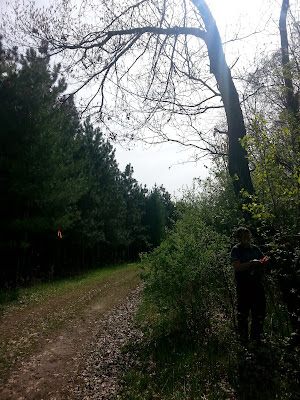In the final lab of the semester we once again traveled to the Priory where we had conducted the last 2 labs. We had the opportunity this week to be presented with a basic tutorial of UAV (unmanned aerial vehicles) work in the field to collect data. Dr. Joe Hupy as well as one of our fellow students, Mike Bomber walked us through the entire process of preparing the UAV, setting the flight route, actually flying the craft and then viewing the data and collecting GCPs (ground control points).
Methods
The Priory was a good area to fly the UAVs because it there are portions of open land that do not intersect with regions where there is high activity. The first step when using the UAVs in the field is to complete the pre-flight checklist (Fig. 1). It is imperative to follow these steps to the letter in order to ensure that errors can be minimized since a single error can cause your aircraft to be permanently damaged.
 |
| (Fig. 1) Dr. Joe Hupy, Mike and Zach prepare for the UAV flight by going through the pre-flight checklist. |
1. Measure weather variables: temperature, wind speed, wind direction etc.
-Temperature was 52 degrees F wind speed in this case was between 2 and 8 mph, wind direction was southeast.
2. Check electrical connections:
-Motor, antenna and frame connected, propellers, battery and antenna secure
-While completing this portion of the checklist we ran into a problem. When the battery pack was put into the Iris UAV controller, they began to smoke so a few students assisted Mike in going back to campus to get new batteries for the controller.
3. Power up the equipment
4. Connect devices to internet modem
-It is important to connect the UAV and the computer program used to determine the route of the flight and other specs to the internet so that the program can show the UAV location in relation to satellite images to make it easier to plan a flight mission
5. Connect base station to UAV
-The base station is based on GPS
6. Make sure that the battery is at greater than 80% power
-It is extremely important to make sure that the battery on the UAV is greater than 80% because they use a great deal of power to fly. You want the battery to be so full because you never know if there are going to be issues and more battery life is needed while you are flying the UAV.
7. Transmitter should be on
8. Make sure that the area is secure
-It's important to make sure that the area in which you are flying the UAV is secure. We found that when we were flying the Matrix UAV the wind made it necessary to land before the flight mission was complete. Because the wind was so strong the UAV could not land in the original starting point and our class had to move around a lot to make sure we did not get in the way of its landing procedure.
9. Turn sensors on
10. Turn on the camera
-A wide variety of cameras can be mounted to the UAVs themselves to collect imagery while they are flying their missions. The Isis UAV used a GoPro camera for example.
11. Complete the take off sequence
12. Fly the planned mission
13. Land the UAV
14. Disconnect the UAV and program
15. Complete a post flight log report
 |
| (Fig.2) Dr. Hupy and Mike disconnect the UAV after it has completed the flight mission. |
 |
| (Fig. 3) This is the Iris UAV craft. |
 |
| (Fig. 4) This is the Matrix UAV while in flight. |
While students collect the GCPs throughout the study area, Dr. Hupy ran a process whih mosaic's all the images collected by the camera attached to the UAV together to provide the viewer with a consistent, single image of the study area (Fig. 5).
 |
| (Fig. 5) Once the program creates the mosaic of the many images taken by the UAV camera we can see a more complete rendering of our study area. |
I really enjoyed this lab because it gave us an opportunity to work with UAVs (even if just indirectly) which is not something that a lot of universities offer. It was interesting as well to gain a better perspective on the impact that these units could have on society as a whole. While it can collect invaluable geographic information, it is a bit creepy the amount of detail that these UAVs can capture in the imagery (Fig. 6).












